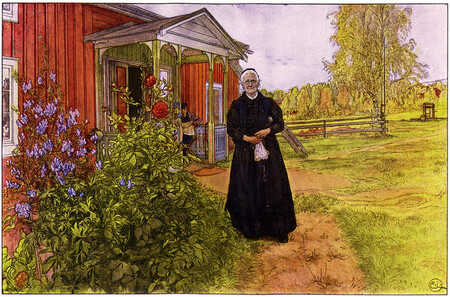5040-Y80R. That is the approximate designation according to the Natural Color System chart for the color ‘falu red’. It is a registered trademark and goes beyond being a simple color: it implies that a very specific pigment comes into play in its production that gives it that reddish tone and has transcended to the point of being part of the identity of an entire country thanks to its properties.
That country is Sweden, and it all started as a waste product from a copper mine.
By-product. Dalarna is a region located in the heart of Sweden, and it is home to the Great Copper Mountain of Falun. The Vikings were already exploiting this mine in 850, but the history of the color dates back to the 16th century. It was then that they discovered that one of the mining byproducts could be turned into a useful pigment.
Leaf
From copper production, what they called Falu rödfärg, or “red mulch,” was obtained, and it was basically a unique mixture of more than 20 different minerals. The reddish color was thanks to iron oxide, silica, zinc and copper itself. They began to mix it with water, but also with other elements such as oils, tar or rye flour, and discovered that they could obtain a paint with very interesting properties.
better than paint. This red mulch mixed with the appropriate ingredients not only gave color to the wood, a primary raw material in Sweden for both ships and infrastructure, but also acted especially well as a protector of the material.
It was like an insulating layer, a shield that protected it against the elements, prolonging its useful life, making repairs less frequent and, in addition, it was cheaper than importing wood treatments from other countries.
The industry soon exploded. It is estimated that by the mid-1760s production was about 25 tons, but by 1930, annual production exceeded 2,000 tons.


Status. Now, it wasn’t cheap. Everyone wanted to paint their house that coppery red color, but it turns out that it was a luxury reserved for the highest classes. When the pigment was discovered, and perhaps motivated only by its color, King John III ordered the ceilings of his palace to be painted with ‘falu red’, imitating the copper on the ceilings of other European palaces. Since then, those with the most power who could get hold of the pigment began to paint their houses.
However, as production began to scale and gain traction, the product became cheaper and more people were able to access it, painting, if not all of their houses, the façade that faced the roads (which was what everyone passing by could see). Swedish artists of the 19th century helped popularize the image of Sweden’s red houses, immortalizing the idea of rural life in red houses with white corners.

One of Carl Larsson’s works
The color of a nation. The color 5040-Y80R became the symbol of Sweden to the point that migrants who sought better luck in North America after the dissolution of the Swedish-Norwegian union in 1905 began to build their farms using this color.
The image that many of us have of the farm in red was created there. And it became so important to Swedish popular culture that there is a saying that symbolizes that simple and harmonious life in contact with the land: the red cabin and the potato country (the red house and the potato garden).
Today, the ‘Falu rödfärg’ is not as vital as it was years ago if we talk about production. It has decreased greatly due to greater competition and synthetic products to paint the facades, but it is still an example of “banal nationalism”, a symbol that exists without the need for flags and anthems, since its mere presence evokes belonging.
Imágenes| Xauxa Håkan Svensson, Frdr, HCa, Wigulf~commonswiki
In WorldOfSoftware | The world’s technology industry practically depends on a single road: the one that leads to the Spruce Prine mine
